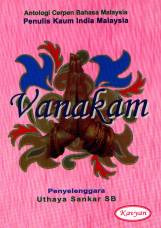
The Voice of Malaysian Indian Writers: The Struggle and the Acheivement
Vanakam
from Malaysian Indian Writers
History
has been created. The very first compilation of Bahasa
Malaysia short stories by Malaysian Indian writers
was published in 2002.
Vanakam,
the title of the compilation, is a very common Tamil language word. It means
“Good day” – and can be used any time of the day, or night. Frankly
speaking, the publicity for this book was started as early as 1998; that’s
four years before the book was actually published.
Back
then, Uthaya Sankar SB compiled 15 Bahasa Malaysia stories by six writers.
Vanakam was the title of the compilation approved for publication – and later rejected by Dewan Bahasa dan Pustaka (DBP) for the sole reason that Uthaya as the compiler used the term “Bahasa Malaysia” when refering to the language in which all 15 stories were written.
[Read
all about the issue HERE]
Four
years later, Uthaya self-published Vanakam
with finance support from the
writers involved in this project. Vanakam
was published as part of Kavyan
project. Finally the book is on the shelves and awaits reaction from readers.
As
mentioned earlier, Uthaya started publicity for Vanakam
nearly five years ago. He’d
answer any phone call with a “vanakam”. And he still does. His cute
Kancil carried a “Vanakam”
sticker. Now his black Perdana V6 parades one.
Nowadays,
“Vanakam”
has become such a common word even among non-Tamil speaking Malaysian. So,
finally, when Vanakam
was published, everyone found the
title familiar; and catchy.
For
those who still have no idea what “vanakam” means, the blurb gives
all the details – including how to express ‘vanakam’ with your
hands.
Compiling
the first Vanakam
anthology in 1998 was an
interesting experience, recalls Uthaya. Things got even more interesting once
DBP decided to stop press once he did not approve to the idea of replacing the
term “Bahasa Malaysia” with another term.
“And
it was such a beautiful experience compiling the new Vanakam
anthology which was published in
2002,” he admits. “Tiring, yes. But at the end of the day, the ten writers
involved created history: our stories are now included in the very first
anthology of Bahasa Malaysia short stories by Malaysian Indian writers.
Something to be very proud of. An accomplishment for Kavyan!”
History
should have been created in 1999, but no thanks to DBP, it took nearly four more
years to make it a reality. Four of the writers involved in the 1998 Vanakam
are also involved in the 2002 Vanakam.
The other two opted out without any specific reason. Anyway, six new writers
joined the project of publishing Vanakam
in 2002.
Saroja
Theavy Balakrishnan’s Gemerlapan, a compilation of short stories, was
published in 1997. Uthaya Sankar SB’s stories are compiled in Orang Dimensi,
Siru Kambam, Yang Aneh-aneh, Nayagi, Surat Dari Madras
and Sasterawan Pulau Cinta. But Vanakam
is the very first anthology of
short stories by ten Malaysian Indian writers.
All the stories in Vanakam revolve around Malaysian Indian characters: their culture, beliefs, religion, politics, problems etc. Selection was made in order to present an insight of the community to Bahasa Malaysia readers.

Do
not expect stories about Indians suffering in rubber estates or in Tamil
schools. No free propaganda for any Indian political leaders in this anthology.
All the writers talk about more interesting – and more important – matters.
Thankyouverymuch.
A
wife in Sritharanee Subramaniam’s story wonders why her husband
doesn’t want to become a father. Bathmavathi Krishnan takes a look into
gangsterism and how love can make a difference in “I Love You, Raj”.
“Cat”
by Uthaya Sankar SB is not only about gender bias but also about a cat
(and his name is “Cat”) who wants to become the leader of the country.
Meanwhile, Retna Devi Balan includes Indian music in her “Kamovarthini”.
If
you are wondering why Indian girls are too shy when it comes to love, join Vijayaletchumy
Vellasamy to help her character pour his love to a neighbour. Or you may
find interest in M. Mahendran’s story about a Chinese girl brought up
in an Indian family.
Domestic
violence and issues of a good-for-nothing husband is portrayed by S. G.
Prabhawathy while Saroja Theavy Balakrishnan talks about survival of
Indians in the near future.
Raja
Rajeswari Seetha Raman takes us on a flight to France and Ganesan
Duraisamy blames parents regarding problematic teenagers.
Each
and every story in Vanakam
deals with a different issue –
but they are all regarding Malaysian Indians today. Written in simple Bahasa
Malaysia, Vanakam
is an easy way for every Malaysian
to understand Malayian Indians better.
Above
all, Malaysian Indian writers have proven – with or without DBP’s content,
thankyouverymuch – that Indians in Malaysia not only love Bahasa Malaysia as a
national language but are also able to master the language and express
themselves through Bahasa Malaysia fiction.
And this happens to be just the beginning of the history. …
Vanakam is available at Silverfish Books, Bangsar, KL (Tel: 03-22844837) and also from Uthaya Sankar SB’s website, . Contact uthayasb@tm.net.my for details about Uthaya’s next endeavor.
Risalah Online ArahKiri, January 2003